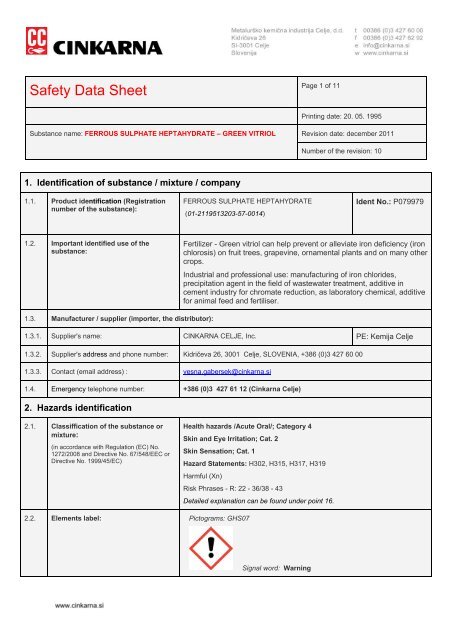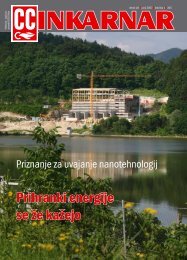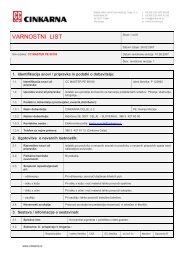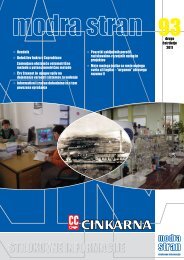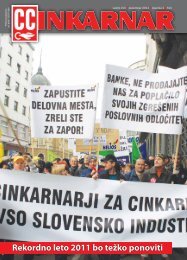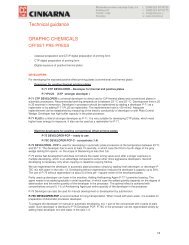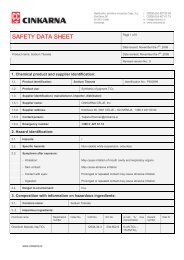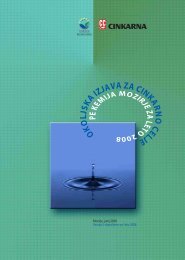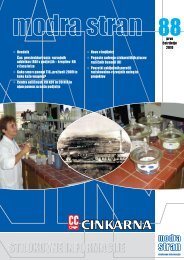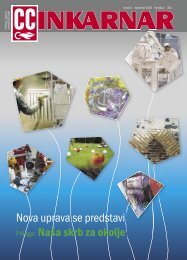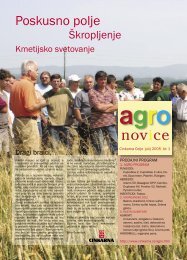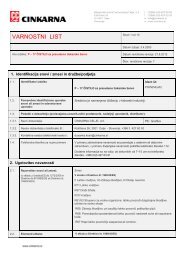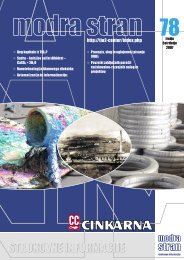Safety Data Sheet - Cinkarna Celje
Safety Data Sheet - Cinkarna Celje
Safety Data Sheet - Cinkarna Celje
Create successful ePaper yourself
Turn your PDF publications into a flip-book with our unique Google optimized e-Paper software.
<strong>Safety</strong> <strong>Data</strong> <strong>Sheet</strong><br />
Page 1 of 11<br />
Printing date: 20. 05. 1995<br />
Substance name: FERROUS SULPHATE HEPTAHYDRATE – GREEN VITRIOL Revision date: december 2011<br />
1. Identification of substance / mixture / company<br />
1.1. Product identification (Registration<br />
number of the substance):<br />
1.2. Important identified use of the<br />
substance:<br />
1.3. Manufacturer / supplier (importer, the distributor):<br />
FERROUS SULPHATE HEPTAHYDRATE<br />
(01-2119513203-57-0014)<br />
Number of the revision: 10<br />
Ident No.: P079979<br />
Fertilizer - Green vitriol can help prevent or alleviate iron deficiency (iron<br />
chlorosis) on fruit trees, grapevine, ornamental plants and on many other<br />
crops.<br />
Industrial and professional use: manufacturing of iron chlorides,<br />
precipitation agent in the field of wastewater treatment, additive in<br />
cement industry for chromate reduction, as laboratory chemical, additive<br />
for animal feed and fertiliser.<br />
1.3.1. Supplier's name: CINKARNA CELJE, Inc. PE: Kemija <strong>Celje</strong><br />
1.3.2. Supplier's address and phone number: Kidričeva 26, 3001 <strong>Celje</strong>, SLOVENIA, +386 (0)3 427 60 00<br />
1.3.3. Contact (email address) : vesna.gabersek@cinkarna.si<br />
1.4. Emergency telephone number: +386 (0)3 427 61 12 (<strong>Cinkarna</strong> <strong>Celje</strong>)<br />
2. Hazards identification<br />
2.1. Classiffication of the substance or<br />
mixture:<br />
(in accordance with Regulation (EC) No.<br />
1272/2008 and Directive No. 67/548/EEC or<br />
Directive No. 1999/45/EC)<br />
Health hazards /Acute Oral/; Category 4<br />
Skin and Eye Irritation; Cat. 2<br />
Skin Sensation; Cat. 1<br />
Hazard Statements: H302, H315, H317, H319<br />
Harmful (Xn)<br />
Risk Phrases - R: 22 - 36/38 - 43<br />
2.2. Elements label: Pictograms: GHS07<br />
Detailed explanation can be found under point 16.<br />
Signal word: Warning
<strong>Cinkarna</strong> <strong>Celje</strong>, <strong>Safety</strong> <strong>Data</strong> <strong>Sheet</strong> Page 2 of 11<br />
Substance name: FERROUS SULPHATE HEPTAHYDRATE – GREEN VITRIOL<br />
2.3. Other hazards:<br />
Hazard Statements: H302, H315, H317, H319<br />
Precautionary Statements:<br />
Prevention: P280<br />
Response: P301 + P312, P302 + P352, P305 + P351 + P338, P310<br />
Disposal: P501<br />
3. Composition / information on ingredients<br />
3.1./<br />
3.2.<br />
Xn<br />
HARMFUL<br />
Risk phrases – R: 22 – 36/38 - 43<br />
Register of phrases – section 16.<br />
Substance / mixture FERROUS SULPHATE HEPTAHYDRATE – GREEN VITRIOL<br />
In accordance with Regulation (EC) No. 1272/2008<br />
Chemical name Index No: not specified<br />
Iron (2+) sulphate<br />
In accordance with Directive 67/548/EEC<br />
EC No.: 231-753-5<br />
CAS No.: 7782-63-0<br />
(heptahydrate) and<br />
7720-78-7 (water free<br />
form)<br />
Chemical name Index No: not specified<br />
Iron (2+) sulphate<br />
EC No.: 231-753-5<br />
CAS No.: 7782-63-0<br />
(heptahydrate) and<br />
7720-78-7 (water free<br />
form)<br />
Concentration<br />
> 80 wt. %<br />
Concentration<br />
> 80 wt. %<br />
Hazard phrases<br />
(H)<br />
302, 315, 317, 319<br />
Hazard<br />
symbol<br />
Xn<br />
Class and category of risk<br />
Health Hazards /Acute Oral/ ;<br />
Category 4<br />
Skin and Eye Irritation; Cat. 2<br />
Skin Sensation; Cat. 1<br />
Risk Phrases ( R )<br />
22 – 36/38 - 43
<strong>Cinkarna</strong> <strong>Celje</strong>, <strong>Safety</strong> <strong>Data</strong> <strong>Sheet</strong> Page 3 of 11<br />
Substance name: FERROUS SULPHATE HEPTAHYDRATE – GREEN VITRIOL<br />
4. First aid measures<br />
4.1. Description of the first aid<br />
After inhalation: The patient is immediately removed from the contaminated area into fresh air or<br />
into well ventilated area and is provided with the basic life support. Call medical<br />
support and submit original packaging with label.<br />
After skin contact: Remove contaminated clothing and shoes. Thoroughly wash the affected parts of<br />
the body with water and soap.<br />
After eye contact: Rinse the opened eye for 15 minutes under running water. Apply a loose bandage<br />
and consult an ophthalmologist.<br />
After swallowing: Rinse the affected mouth with water and drink 2 dl of water. Remain calm, keep<br />
warm and obtain medical assistance immediately.<br />
4.2. The most important symptoms and<br />
effects both acute and belated:<br />
4.3. Indication of any immediate medical<br />
care and special treatment:<br />
5. Fire fighting measures<br />
5.1. Extinguishing media<br />
Various tests indicate possible occurence of nausea, vomiting and diarrhea.<br />
Change of colour of mud to pink ia an indicator of poisoning with iron.<br />
If necessary, decontaminate the skin and mucous membranes.<br />
Obtain medical assistance immediately.<br />
Suitable extinguishing agents: Dry extinguishing resource, carbon dioxide (CO2), foam.<br />
Unsuitable extinguishing agents: Do not use direct water jet.<br />
5.2. Specific risks associated with the<br />
substance or mixture:<br />
5.3. Advice for Firefighters: Not required.<br />
6. Accidental release measures<br />
6.1. Personal precautions, protective<br />
equipment and emergency<br />
procedures<br />
6.1.1. For non-gualified persons: See section 6.3.2<br />
6.1.2 For rescuers: See section 4.1<br />
In the case of fire – the material may yield irritating decomposition products such<br />
as sulfur trioxide and sulfur dioxide.<br />
6.2. Environmental precautions If the water pollution – inform the competent services.<br />
6.3. Methods and materials for<br />
containment and cleaning<br />
6.3.1. Appropriate spill containment<br />
techniques:<br />
6.3.2. Appropriate cleaning procedures<br />
In the event of substance being mixed with water – prevent (substance cover with<br />
soil or other absorbent materials) the spread into the underground drainage pipe<br />
system or streams.
<strong>Cinkarna</strong> <strong>Celje</strong>, <strong>Safety</strong> <strong>Data</strong> <strong>Sheet</strong> Page 4 of 11<br />
Substance name: FERROUS SULPHATE HEPTAHYDRATE – GREEN VITRIOL<br />
Techniques of neutralization: Cover the substance with soil, peat or other neutral absorbent material.<br />
Decontamination techniques: Spillage: protect the affected area; danger warnings must be placed in order to<br />
protect the contaminated area; notify responsible authorities about the existing<br />
danger; withdraw all workers against the direction of the wind; use personal<br />
protective equipment (as described in 4.1); call the relevant Center for more<br />
Information.<br />
Absorbent materials: Neutral absorbent materials: soil, turf, sand or other absorbent material.<br />
Cleaning techniques: In the case of spillage pick up the substance with a shovel and place it into a<br />
clean and labeled container with a fully sealable lead. Do not breathe in the dust.<br />
If the substance can not be re-used it should be disposed of in accordance with<br />
the applicable Rules of the disposal of hazardous waste.<br />
If the substance is mixed with absorbent material in moisture soil, it should be<br />
mechanically removed like hazardous waste. We use personal protective<br />
equipment (read 4.1).<br />
After work the soil and dirty objects area is washed with water and detergent.<br />
Waste water should not enter drain systems or watercourses.<br />
Suction techniques: Use industrial vacuum cleaner for dry cleaning – wet and dry vacuum cleaners<br />
(with a brush, with adapter for dust).<br />
The equipment needed for containment<br />
/ cleaning:<br />
The equipment used depends on the type and extent of contamination.<br />
Cleaning is carried out under supervision of experts. It usually takes fire<br />
management intervention.<br />
6.3.3. Improper cleaning techniques: Retention in the direction of the wind; rinse with water before the substance is<br />
mechanically removed; use of detergent with an acid reaction.<br />
6.4. References to other sections: Not required.<br />
7. Handling and storage<br />
7.1. Precautions for safe handling<br />
7.1.1. Recommendations<br />
Safe handling with the substance or<br />
mixture:<br />
Prevent treatment with incompatible<br />
materials:<br />
Prevent releases of substance or<br />
mixture:<br />
7.1.2. General hygiene (eating, drinking and<br />
smoking is strictly prohibited in working<br />
areas; washing hands;...):<br />
7.2. Conditions for dafe storage,<br />
including the incompatibility<br />
Use in well ventilated area. Accumulation of dust and powder should be reduced<br />
to a minimum. Mandatory use of personal protective equipment (read section<br />
8.2.2). Follow instructions for safe handling of hazardous materials and<br />
instructions on safety and health at work.<br />
Follow all instructions for the work and SDS.<br />
Follow all instructions for the work and SDS.<br />
Use personal protective equipment. Upon completion of work protective clothing<br />
must be washed. Likewise the person must wash their hands with water and<br />
soap. Even during the break workers should wash their hands.<br />
While working you should not eat, drink or smoke.
<strong>Cinkarna</strong> <strong>Celje</strong>, <strong>Safety</strong> <strong>Data</strong> <strong>Sheet</strong> Page 5 of 11<br />
Substance name: FERROUS SULPHATE HEPTAHYDRATE – GREEN VITRIOL<br />
Command the risks associated with<br />
- explosive atmospheres: It isn’t prescribed.<br />
- corrosive substances: Not specified.<br />
- incompatible substances or<br />
mixtures:<br />
- volatile substances: Not specified.<br />
- potential sources of ignition: Unspecified.<br />
Control effects<br />
Substances alkaline reaction, soluble carbonates, substances which oxidize.<br />
- weather conditions: Substance shouldn't be exposed to rain and shouldn't be used in areas with high<br />
humidity.<br />
- environmental pressure: Unspecified.<br />
- temperature: Room temperature.<br />
- solar light: Substance must be separated from direct sunlight.<br />
- humidity: The substance is hygroscopic.<br />
- vibration: Not specified.<br />
Ensuring the itegrity of the substance<br />
or mixture by the use of<br />
- stabilizers: Not required.<br />
- antioxidants: Not required.<br />
Other advices including the following<br />
- requirements on prevention: Keep in original packaging (closed and labeled) in a well ventilated area in a dry,<br />
cool place (room temperature), away from children, animals and unauthorized<br />
people.<br />
- specific constructions for<br />
storehouse:<br />
Protect from direct sunlight.<br />
Specific constructions are not required.<br />
- limits by storage conditions: Limit quantities are not provided by proper storage.<br />
- compatibility with packaging: Substance is compatible with the packaging.<br />
7.3. Specific end use: Use only in accordance with instructions (point 1.2).<br />
8. Exposure controls / personal protection<br />
8.1. Control parameters<br />
8.1.1. Threshold limit value (TLV):
<strong>Cinkarna</strong> <strong>Celje</strong>, <strong>Safety</strong> <strong>Data</strong> <strong>Sheet</strong> Page 6 of 11<br />
Substance name: FERROUS SULPHATE HEPTAHYDRATE – GREEN VITRIOL<br />
DNEL Iron is an essential metal.<br />
Acute – systemic and long-term effects:<br />
Workers (dermal) = 0.57 mg/kg<br />
Workers (inhalation) = 2 mg/m 3<br />
General population:<br />
PNEC Sediment: 49.5 g/kg<br />
8.2. Exposure controls<br />
Dermal = 0.29 mg/kg; inh. = 0.5 mg/m 3 ; oral = 0.29 mg/kg<br />
Source: GESTIS, Voestalpine Stahl GmbH-Austria<br />
Soil: 55 g/kg<br />
Water treatment: 500 mg/L (microbiological activity)<br />
Atmosphere – air: no relevant exposure to be expected<br />
Source: CSR - Voestalpine Stahl GmbH-Austria<br />
8.2.1. Appropriate controls: Ventilation (local and spatial).<br />
8.2.2. Personal protection<br />
- respiratory protection: In the event of dust or mist, use respiratory protection mask with combination filter<br />
P2 or P3.<br />
- skin protection: Acid-resistant clothing. Precautionary skin protection required. After working with<br />
the material, wash hands and face with plenty of water and apply lotion to skin.<br />
- hand protection: Gloves made of natural latex, nitrile, polychloroprene, butyl rubber gloves are<br />
generally suitable. Permeation and penetration times may vary according to<br />
design and are provided upon request by the manufacturer.<br />
- eye / face protection: Wear protective goggles with side protection.<br />
- heat hazard: There are no thermic dangers.<br />
Other:<br />
8.2.3. Environmental exposure controls: Contaminated water from fire should not be spilled into drains or watercourses.<br />
We must prevent the development of dust – to ensure adequate ventilation and<br />
separate collection and disposal to an appropriate landfill regulated under the<br />
current Rules on the disposal of hazardous waste.<br />
9. physical and chemical properties<br />
9.1. Information on basic physical and<br />
chemical properties<br />
- form: Crystalline powder<br />
- colour: Light green<br />
Informations for section 8 are from Voestalpine Stahl GmbH-Austria.
<strong>Cinkarna</strong> <strong>Celje</strong>, <strong>Safety</strong> <strong>Data</strong> <strong>Sheet</strong> Page 7 of 11<br />
Substance name: FERROUS SULPHATE HEPTAHYDRATE – GREEN VITRIOL<br />
- odour: Slightly acidic<br />
- pH: Approx. 2.3 at 100 g/L water<br />
- melting point: Hydrate water is released from the ferrous sulfate at approx. 64 o C and a<br />
solution of ferrous sulfate forms in its own hydrate water emerges.<br />
- boiling point: No boiling point before decomposition.<br />
- flash point: Not required (solid).<br />
- evaporation rate: Not applicable.<br />
- flammability: The material is not combustible.<br />
- upper / lower flammability or explosive<br />
limits:<br />
Not applicable.<br />
- vapour pressure: Not applicable. Inorganic solid compound.<br />
- vapor density: Not applicable.<br />
- relative density: n.a.<br />
- solubility: Water: from 25 to 26 g FeSO4 / 100g (20 o C). more than 12 % Fe soluble in<br />
water.<br />
- partition coefficient: n-octanol/water: n.a.<br />
- decomposition temperature: n.a.<br />
- viscosity: Not required (solid).<br />
- explosives properties: No explosive properties.<br />
- oxidizing solids: Not oxidizing.<br />
9.2 Other information: Bulk density: (850 – 950) kg/m 3<br />
10. Stability and reactivity<br />
10.1 Reactivity: Substance is stabe under normal conditions.<br />
10.2 Chemical stability: Thermal decomposition starting at 400 o C.<br />
10.3 Possibility of hazardous reactions: Formation of sulfur trioxide and sulfur dioxide and basic ferrous (III) sulfate.<br />
10.4 Conditions to be avoided: Moisture (substance is hygroscopic), substances alkaline reaction, soluble<br />
carbonates, substances which oxidize.<br />
10.5 Incompatible materials: Substances alkaline reaction, soluble carbonates, substances which oxidize.<br />
10.6 Hazardous decomposition<br />
products:<br />
Sulfur trioxide, sulfur dioxide.
<strong>Cinkarna</strong> <strong>Celje</strong>, <strong>Safety</strong> <strong>Data</strong> <strong>Sheet</strong> Page 8 of 11<br />
Substance name: FERROUS SULPHATE HEPTAHYDRATE – GREEN VITRIOL<br />
11. Toxicological information<br />
11.1 Podatki o toksikoloških učinkih<br />
- acute toxicity: LD50 oral. (rat) = 500 - 2000 mg/kg - /tests result/<br />
Acute Oral; Category 4<br />
Acute inhalation: No classification.<br />
LD50 derm. (rat) = > 2000 mg/kg - /tests/<br />
No classification.<br />
Skin sensation: Category 1<br />
Source: Voestalpine Stahl GmbH-Austria<br />
- skin corrosion / irritation: Tests with rabbits: Category 2<br />
For solutions of concentration ≥ 10 %.<br />
Ferrous sulphate should not be seen as corrosive just as an irritant.<br />
Source: Voestalpine Stahl GmbH-Austria<br />
- serious eye damage / irritation: Eye irritation: Category 2<br />
- sensitization by inhalation and skin<br />
sensitization:<br />
Results are available for a GLP-compliant guideline study (Johnson, 2003), wich<br />
showed that a 25% solution of ferrous sulphate heptahydrate caused no more<br />
than mild redness and chemosis after instillation into the rabbit eye.<br />
Skin sensation: Category 1<br />
- germ cell mutagenicity: Not classified<br />
- carcinogenicity: Not classified<br />
- reproductive toxicity: Not classified<br />
Iron salts have been extensively tested (vitro and vivo tests).<br />
It is concluded that iron salts are not genotoxic.<br />
Source: Voestalpine Stahl GmbH-Austria<br />
Because of its potential pro-oxidant effects, studies include many clinical<br />
investigations.<br />
Source: Voestalpine Stahl GmbH-Austria<br />
NOAEL ≥ 500 mg/kg body weight/day (no adverse effects were observed)<br />
In humans, iron supplementation of about 5.8 to 11.7 mg/kg bw/day is routinely<br />
prescribed throughout pregnancy with no adverse effects on pregnancy outcome.<br />
Source: Voestalpine Stahl GmbH-Austria
<strong>Cinkarna</strong> <strong>Celje</strong>, <strong>Safety</strong> <strong>Data</strong> <strong>Sheet</strong> Page 9 of 11<br />
Substance name: FERROUS SULPHATE HEPTAHYDRATE – GREEN VITRIOL<br />
- STOT – single exposure: Not classified<br />
- STOT – repeated exposure: Not classified.<br />
- aspiration hazard: Not classified<br />
12. Ecological data<br />
Source: Voestalpine Stahl GmbH-Austria<br />
Source: Voestalpine Stahl GmbH-Austria<br />
12.1. Toxicity: The substance is not classified.<br />
In general toxic effects will not be seen be the presence of ferrous sulphate in the<br />
environment. However ferrous sulphate may present a toxic hazard to<br />
environmental species under specific conditions. For example, it is possible that<br />
ferrous iron salts could have toxic effects in circumstances where the following<br />
conditions apply and persist: pH is low (
<strong>Cinkarna</strong> <strong>Celje</strong>, <strong>Safety</strong> <strong>Data</strong> <strong>Sheet</strong> Page 10 of 11<br />
Substance name: FERROUS SULPHATE HEPTAHYDRATE – GREEN VITRIOL<br />
12.5. Results of PBT and vPvB<br />
assessment:<br />
12.6 Other adverse effects:<br />
13. Disposal considerations<br />
The substance is not considered to PBT/vPvB.<br />
The criteria for persistence, bioaccumulation potential and toxicity are not met.<br />
The substance is not PBT or vPvB.<br />
13.1. Methods of waste management: Residues of substances are stored in their original packaging. Waste materials<br />
and packaging are given on rent to an authorized collector of hazardous<br />
substances in accordance with applicable environmental legislation, which<br />
regulates hazardous waste management and the management of packaging and<br />
packaging waste.<br />
14. Transport information<br />
ADR, RID: It is not according as hazardous on the transport regulation.<br />
14.1 UN Number:<br />
14.2 Proper shipping name:<br />
14.3 Class:<br />
14.4 Packaging group:<br />
14.5 Environmental hazards:<br />
14.6 Special precautions:<br />
14.7 Cargo transport with Annex II of<br />
MARPOL 73/78 and the IBC code:<br />
14.8. Tunnel restriction code:<br />
14.9. Classification code:<br />
14.10. Hazard label:<br />
15. Regulatory information<br />
15.1. Regulations / legislation on health,<br />
safety and environment specific<br />
substance:<br />
This substance is a subject to applicable regulations of Fertilizer, Regulation CLP<br />
and the law: safety, occupational health, environmental protection and<br />
management of hazardous chemicals.<br />
15.2 The chemical safety assessment: A chemical safety assessment for the substance is done.<br />
16. Other information:<br />
Indication of changes Classification according to GHS – CLP.<br />
A list of all R phrases, phrases of the<br />
hazard (H) and precautionary<br />
statements (P) from 2 to 15:<br />
R 22 Harmful if swallowed.<br />
R 36/38 Irritating to eyes and skin.<br />
R 43 May cause sensitisation by skin contact.
<strong>Cinkarna</strong> <strong>Celje</strong>, <strong>Safety</strong> <strong>Data</strong> <strong>Sheet</strong> Page 11 of 11<br />
Substance name: FERROUS SULPHATE HEPTAHYDRATE – GREEN VITRIOL<br />
H302 Harmful if swallowed.<br />
H315 Causes skin irritation.<br />
H317 May cause an allergic skin reaction.<br />
H319 Causes serious eye irritation.<br />
P280 Wear protective gloves/protective clothing/eye protection/face protection.<br />
P301 + P312<br />
IF SWALLOWED: Call a POISON CENTER or doctor / physician.<br />
P302 + P352<br />
IF ON SKIN: Wash with plenty of soap and water.<br />
P305 + P351 + P338<br />
IF IN EYES: Rinse cautiously with water for several minutes. Remove contact<br />
lenses, if present and easy to do. Continue rinsing.<br />
P310 Immediately call a POISON CENTER or doctor/physician.<br />
P501 Dispose of contents / container in accordance with national regulations.<br />
Training of workers: A Course of safety, occupational health, fire safety and handling of hazardous<br />
chemicals.<br />
Sources: Regulation (EC) No.: 1907/06; 1272/08; 453/2010; 23/08; 56/10<br />
Commission Directive No.: 2008/58/ES; 2009/2/ES<br />
Voestalpine Stahl GmbH-Austria<br />
Information is based on our knowledge of the product during the preparation of this data sheet. If the buyer does not use the product<br />
as advised he will carry the responsibility of any damages that may occur. Of course, the information in the SDS shall not relieve<br />
anyone of customer duty to take into the account all legislation that is bound to its area of activity.<br />
Word list<br />
CLP = Classification, Labelling and Packaging<br />
CSR = Chemical <strong>Safety</strong> Report<br />
ECB = European Chemicals Bureau<br />
GESTIS = International Limit Values<br />
GHS = Globally Harmonized System<br />
LD50 = Median lethal dose<br />
NOAEL = No observed adverse effect<br />
STOT = Specific Target Organ Toxicity<br />
PEC = Predicted effect concentration<br />
PNEC = Predicted no effect concentration


